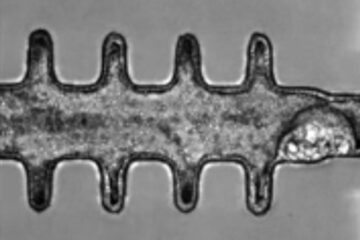International Aphid Genomics Consortium publishes genome sequence of the pea aphid

In a series of landmark papers to appear in journals including PLoS Biology and Insect Molecular Biology, the scientists shed light on the identity of an organism whose genome sequence offers solutions to central questions in basic biology and applied agriculture.
Both a highly destructive pest and highly complex organism, the aphid is known for the damage it causes to crops, feeding on the phloem sap in plants and spreading deadly viruses. Yet aphids have also evolved complex life cycles, alternating between sexual and asexual reproduction, producing offspring with multiple phenotypes and forming symbiotic relationships with inherited bacteria.
Many of these unusual features find their origins in the 35,000 newly-identified genes of the pea aphid genome, 37% of which, the researchers show, are unique to aphids. Among other discoveries, the researchers find a highly increased number of genes associated with reproduction, gene expression, signaling and virus transmission, and a strikingly reduced repertoire of immunity-related genes. At the evolutionary level, the discovery of a dozen functional genes of bacterial origin constitutes the first systematic evidence of horizontal gene transfer from bacteria to a eukaryotic host.
As the world’s most important agricultural pest and one of its most biologically distinctive species, the aphid is of central concern to industry and science alike. The first published aphid genome provides a basis for the development of safer, more effective pest control techniques, while also setting the stage to exploring the genetic basis of a range of complex biological phenomena.
For more information, please contact:
Dr. Atsushi Nakabachi
Miyagishima Initiative Research Unit
RIKEN Advanced Science Institute
Tel: +81-(0)48-467-9329 / Fax: +81-(0)48-467-9329
Ms. Saeko Okada (PI officer)
Global Relations Office
RIKEN
Tel: +81-(0)48-462-1225 / Fax: +81-(0)48-462-1223
Email: koho@riken.jp
Journal information
PLoS Biology and Insect Molecular Biology
Media Contact
All latest news from the category: Life Sciences and Chemistry
Articles and reports from the Life Sciences and chemistry area deal with applied and basic research into modern biology, chemistry and human medicine.
Valuable information can be found on a range of life sciences fields including bacteriology, biochemistry, bionics, bioinformatics, biophysics, biotechnology, genetics, geobotany, human biology, marine biology, microbiology, molecular biology, cellular biology, zoology, bioinorganic chemistry, microchemistry and environmental chemistry.
Newest articles

Solving the riddle of the sphingolipids in coronary artery disease
Weill Cornell Medicine investigators have uncovered a way to unleash in blood vessels the protective effects of a type of fat-related molecule known as a sphingolipid, suggesting a promising new…

Rocks with the oldest evidence yet of Earth’s magnetic field
The 3.7 billion-year-old rocks may extend the magnetic field’s age by 200 million years. Geologists at MIT and Oxford University have uncovered ancient rocks in Greenland that bear the oldest…

Mini-colons revolutionize colorectal cancer research
As our battle against cancer rages on, the quest for more sophisticated and realistic models to study tumor development has never been more critical. Until now, research has relied on…





















